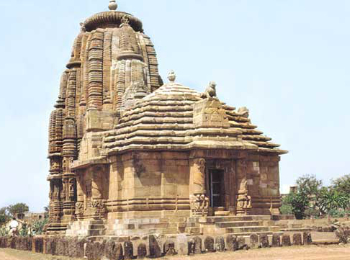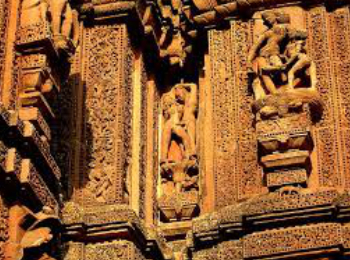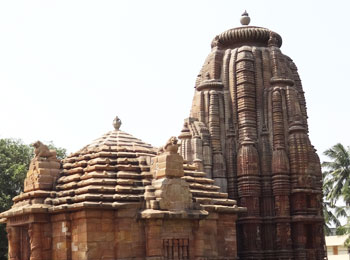- Shiva
Rajarani Temple
Overview:
The Rajarani Temple is a Lord Shiva Temple located at Bhubaneswar, Odisha(Orrisa previously). The temple is located in the district of Khurda. It is more towards the north-eastern part of the Lingaraj Temple. It is a beautiful temple, and is a rather unique experiment in architecture in Odisha. The temple has been mentioned in the traditional Sanskrit texts as Indresvara. The Shiva Temple is known for its grand sculptures, its ornaments, and its grand architectural features. It is also famous for its multiple scroll work. The sanctum does not have a deity. The name of the temple, Rajarani, has been derived from fine-grained yellowish sandstone called Rajarani in common parlance with which the entire edifice has been built. Mellowed by time the glaring amber of the stone complements its architectural splendor. The Rajarani temple was previously known as Indreshwara sanctuary which was devoted to God Shiva and mainly known as ""Love temple"" by virtue of the erotic carvings of ladies and couples in the temple.
About the temple:

Based on the sculptural workmanship and building style, the temple is dated to mid-11th century. Cocoa amasses the temple alongside Anant Vasudev Temple and is dated around 11th-12th hundreds of years back. The sanctuary remains on a raised stage. Porch of the temple is known as Jagamohana and is constructed in the pyramidal structure and it is plain. The Raja Rani temple has the sculpture of the""Guardians of the Eight Direction"" which emerged from the base of temple facing eight directions. They are standing in a clockwise direction from the passage encompassing the yard to end back at the torana. The eight gatekeepers are Indra-God of downpour, Agni-God of flame, Yama-God of death, Nirriti-God of anguish, Varuna-God of sea, Vayu-God of wind, Kubera-God of riches and Ishana (Shiva). Raja temple is based on pancharatha style on a raised stage with two structures a focal sanctuary to be specific the vimana (sanctum) with the bada (the curvilinear tower) over its rooftop raising up to a tallness of 18 m (59 ft) and a review lobby called jagamohana with a pyramidal rooftop . The temple is built of dull red and turbid yellow sandstone mainly called ""Rajarani"". Facing east this temple consists of a sanctum that is about 17.9 metres tall. It has a porch that is raised above a platform of three moldings with a curvilinear superstructure (rekha sikhara) reminiscent of the Kandariya Mahadeva temple of Khajuraho. The temple exhibits yet another phase in the evolution of Odishan temple architecture.
It has a panchanga bada or five divisions such as pabhaga, talajangha, bandhana, uparajangha and baranda. The lowermost division is called pabhaga having five decorative mouldings namely, khura, kumbha, patta, kani and basanta. The superstructure (gandi) of the temple is distinguished by number of miniature turrets (angasikharas). The composite form of the temple with clustering of such miniature turrets multiple recesses and angles make the edifice circular in appearance. Above the superstructure is crowned with a fluted disc shaped architectural members called amalaka. A vase (kalasa) surmounts the amalaka as the crowning final. In a pleasing contrast to the ornate decoration of the sanctum the tiered (pidha) jagamohana the porch is severely plain, though intended to decorate it originally but possibly left incomplete. The plan of jagamohana is square in contradistinction to its rectangular counterparts of earlier temples. The interiors are devoid of any decorations.The monument is noted for its exuberant sculptural wealth of which the naga-nagi sthambha saiva dwarapalas on the entrance door jambs sculpture of Lakulisa on the lintel of entrance above which is the architrave of Navagrahas. The presence of Lakulisa saiva dwarapalas tend to prove its saivite affiliation. The temple has been well preserved, and all the architecture has also been well preserved are the standing astadikpalas on the central fasade of kanika appearing on the jangha portion of the bada clad in diaphanous drapery they stand on lotus with their mounts below. Among the digapalas, the Varuna is intact. It has great ornamentation and well crafted facial expressions. Scenes of marriage of Siva Nataraja, Parvati are some of the important cult images of the temple. Sculptures of women in dance postures hint the practice of Odissi dance. The imageries of women playing with birds and nature are a treat to view. The Raja Rani temple is surrounded by a beautiful garden. The temple is located on an open paddy field area. The foundation of this temple dates back to the 11th century A.D.
Significance:

The devotees visit this temple for matrimony-related wishes.
How to get there or Accessibility:
Air:
Nearest airport for Rajarani Temple is Biju Pattnaik Airport located in 6 Kms.
Rail:
The nearest railway station is Bhubaneswar Railway Station and the distance from Railway Station to Rajarani Temple is 6 Kms.
Road:
Interstate bus services operate daily between Kolkata and Puri via Bhubaneswar and Tatanagar (Jamshedpur).
Rare Fact:
The Temple has no presiding deity. Also the celebrity of the Rajarani temple is also a large extent due to the tall slender sophisticated nayikas gracing the walls of the sanctum particularly on the anurahapagas of the lower jangha carved in bold relief, depicted in various roles and moods in amorous dalliance with actions such as turning her head from an emaciated ascetic fondling her child holding a branch of tree attending to her toilet looking into mirror taking off her anklet caressing her pet bird and playing instrument etc. These nayikas are vivacious and lively with their fascinating facial expressions and elastic movements. The erotic (mithuna) figures carved in high relief on the projecting pagas of the uparajangha are quite notable. Besides the other most popular decorative motifs are carved out in the shape of vyala, jagrata and gajakranta. Further, the most dominant scroll motifs are the foliages creepers and vines (vanalata) and each contains lush foliage independent of any stalk or vine.On the basis of sculptural art architectural style this temple is assignable to circa mid 11th cent. A.D.
Entry fees:
Rs 5 (Indian); Rs 100 (Foreigner)
Festivals celebrated at the RajaRani Temple
The musical festival in Rajarani temple is held in the beautiful courtyard of the Temple in Bhubaneswar. It is one of the occasions where the richness and originality of Indian classical music is celebrated. The evening air is filled with spell binding music by great maestros of Indian Classical music. the Rajarani Temple is one of the most conspicuous temple in the city which has a large assemblage in Odhisa. This is in spite of not having any any presiding deity in it. The Rajarani Music Festival was conceived to be organized by the Department of Tourism in association with organizations like Orissa Sangeet Natak. Musicians from different parts of the country perform during the three-day festival. This festival is held during the month of January. Devotees from different places visit the temple on this occasion.
Where to eat
Tourists should try the authentic Oriya cuisine. There are varieties of food present for vegetarians as well as non vegetarians.The local specialties that one must relish are Machha Jholo (a fish curry), Gupchup, Cuttack Chaat, Aloo Dum, Dahi Pakhal, Badi Choora, Dalma, Santula and more. The sweets that are offered are Pithas, Kora-Khhaii, Rasabali, Chenna Gaja, Chenna Poda and Rasagola. Abadha or the vegetarian food served in temples is also delicious.
Nearby Temples
Lingaraj Temple
Mukteshwar Temple
Brahmeshwar Temple
Yogini Temple
Kedar Gouri Temple
Vaital Deul Temple
Rameshwar Deula
Yameshwar Temple
Weather And Time To Visit
The ideal time to visit the Rajarani Temple would be between October and March. The city experiences extreme climate. It is difficult to go in rainy season because of landslide and uprooting of the trees. Summer is unbearably hot reaches 45 degrees, making each and every one exhausted. The best season would be winter, when the maximum temperature reaches to 15 degrees this would be the best season to visit.
Accommodation
There are many Hotels near the airports and railway station. The Orissa Tourism Development Corporations have also provided good accommodation with spacious rooms for the tourists.
Many private hotels to suit your needs are also available which are very near to the temple making all the visitors very convenient to reach the temple.
Tips For Devotees
They should carry all possible winter wears because of very cool climate which may not suite some of the visitors.
Rules And Rituals Of The Temples
The regular activities performed at the Rajarani Temple include pious rituals, charity and providing foods to the destitute.
Significance
Devotees visit this temple to seek fulfillment of the following:-
- For matrimony-related wishes
Shlokas
Kailaasarana Shiva Chandramouli Phaneendra Maathaa Mukutee Zalaalee Kaarunya Sindhu Bhava Dukha Haaree Thujaveena Shambho Maja Kona Taaree
Meaning -Oh Lord Shiva who is seated on Mount Kailash, where the moon decorates his forehead and the king of serpents crown his head, who is merciful and removes delusion, You alone can protect me. I surrender to thee.
Aum Trayambakam Yajaamahey Sugandhim Pusti Vardhanam Urvaarukamiva Bandhanaath Mrutyor Muksheeya Maamritaat
Meaning -We worship the fragrant Lord Shiva, who has 3 eyes and who cultivates all beings. May He free me from death, for immortality, as even a cucumber is separated from its bond with the vine.
Timings
This temple remains open all days of the week from 6 AM to 6 PM. The best time to visit the temple is October and March. There is also an entry fee for this temple, Rs. 5 for Indians and Rs. 100 for Foreigners.
